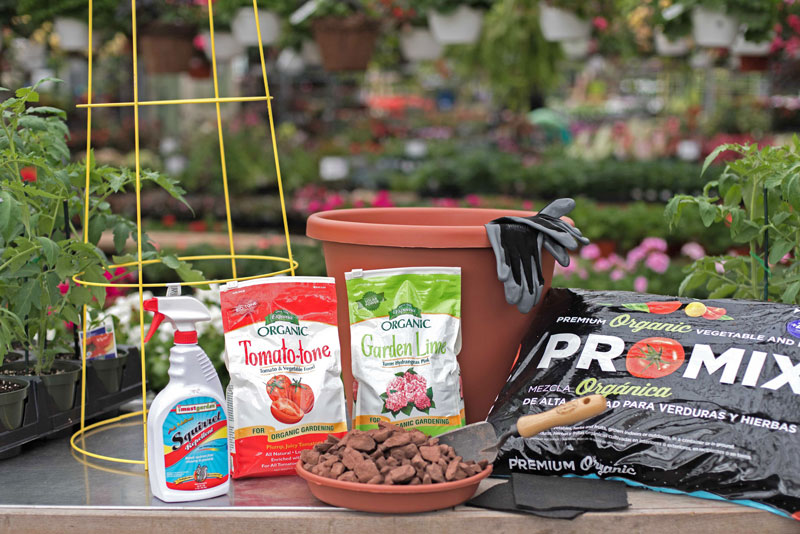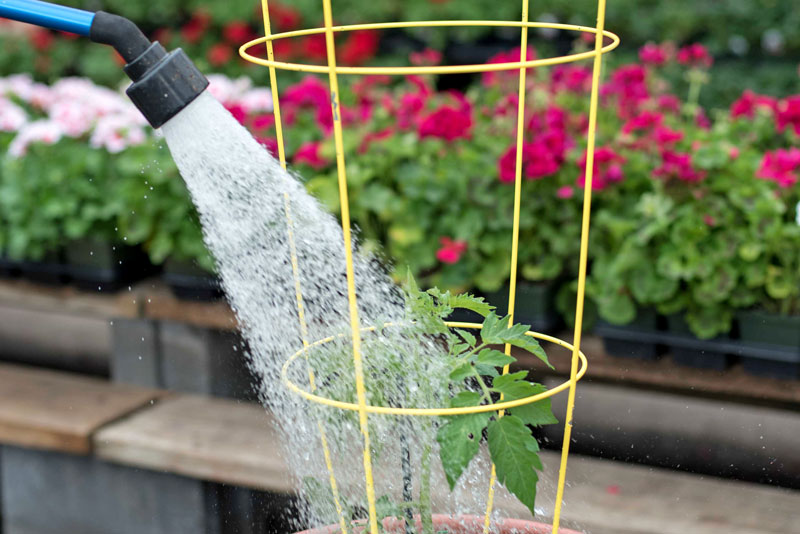
Vegetable Gardens in Small Spaces: Tomatoes
David Yost, Merrifield Plant Specialist
Tomatoes are one of the most popular fruits and vegetables among gardeners as they are both beautiful and delicious! Even if you have limited space, you can grow beautiful tomatoes with a container, adequate sunlight and a little planning.
Tomatoes can grow in a variety of conditions, but will produce the best fruit in a location with 6 to 8 hours of sun per day. Before you begin your tomato container garden, check your yard or patio at a few different times throughout the day to determine the best location for your plant.
Step one: Choose your tomato
You can grow just about any kind of tomato in a container if you are willing to work with vines that can reach 8 feet tall or more. I like to grow the Celebrity variety in containers for its hardiness, flavor and manageable size. ‘Celebrity’ typically grows to about 5 feet, making it a manageable choice.
Step two: Gather your supplies
Before you begin planting, you will want to make sure you have the following items:
- Container: Your container should be a minimum of 16” in diameter for one tomato plant. With tomatoes, bigger is always better when it comes to containers. Today I’m using a plastic pot, but you can use almost any container as long as it has a hole in the bottom for drainage. You can also use an EarthBox, which has a sub-irrigated watering system that can increase time between watering.
- Potting soil: We recommend using a lightweight potting soil, such as Pro Mix Organic Vegetable and Herb, for container-grown tomatoes. For one tomato plant in a 16” pot, you will need two 16 qt. bags of potting mix.
- Small square of landscape fabric: Place this over the drainage hole in the bottom of the pot to prevent soil from escaping and keep your patio clean. This will also prevent critters from coming into the pot.
- Tomato cage or other support structure: To keep your tomato contained within the pot, we recommend using a tomato cage or a plant stake to support the vine.
- Fertilizer: I like to use an organic fertilizer, such as Espoma Tomato Tone, for my edible gardens. You can also use an inorganic, slow release granular, such as our Merrifield Flowering Plant Food or Osmocote.
- Granular lime: I like to mix lime in with my tomatoes to prevent disease and boost growth.
- Squirrel repellent: I have lots of squirrels in my yard so I use a squirrel repellant to discourage them from tampering with my tomato plant. I like the I Must Garden brand as it’s organic.
- River jack stones or seminole chips: You’ll use these to cover the top of the container surface. This will protect your plants from squirrels and preventing dirt from washing out of the top of the pot.
- Hand shovel
- Gardening gloves
- Watering wand and hose
Step three: Plant
Since your container can be heavy once its filled with the soil, we recommend setting the container in place before you plant your tomatoes.
- Place your piece of landscape fabric over the drainage hole in the bottom of the pot.
- Fill your container 2/3 of the way with potting soil.
- Add your fertilizer and lime to the potting soil and mix with your hand shovel. Be sure to follow the instructions on the label to determine the appropriate amount of fertilizer and lime to mix in.
- Add your tomato plant. Break up the roots and remove the bottom set of leaves before placing your plant in the pot. You can cover your tomato with soil all the way up to the second set of leaves.
- Top off the container with soil, but keep it an inch from the top of the container to keep it from spilling over the sides as you water.
- Place your tomato cage in the pot. You will want to do this right after planting to prevent the cage from damaging the root system of the tomato.
- Cover the surface of the soil with a half-of-an-inch of small river jacks or seminole chips.
- As an extra layer of protection, spray your tomato with squirrel repellent.
Step four: Water and nourish
Once your container is set, water it thoroughly. Run the water over your container, letting it drain out of the bottom. Tomato plants need to be watered frequently to maintain consistent moisture in the soil. The soil should not be allowed to dry out. During hot weather, you will likely need to water your tomato plant daily.
For the best tomatoes, we recommend feeding your plant every 2-4 weeks with fish emulsion.
Your plant will be ready to harvest later this summer, and will continue to produce fruit through the end of the season.





